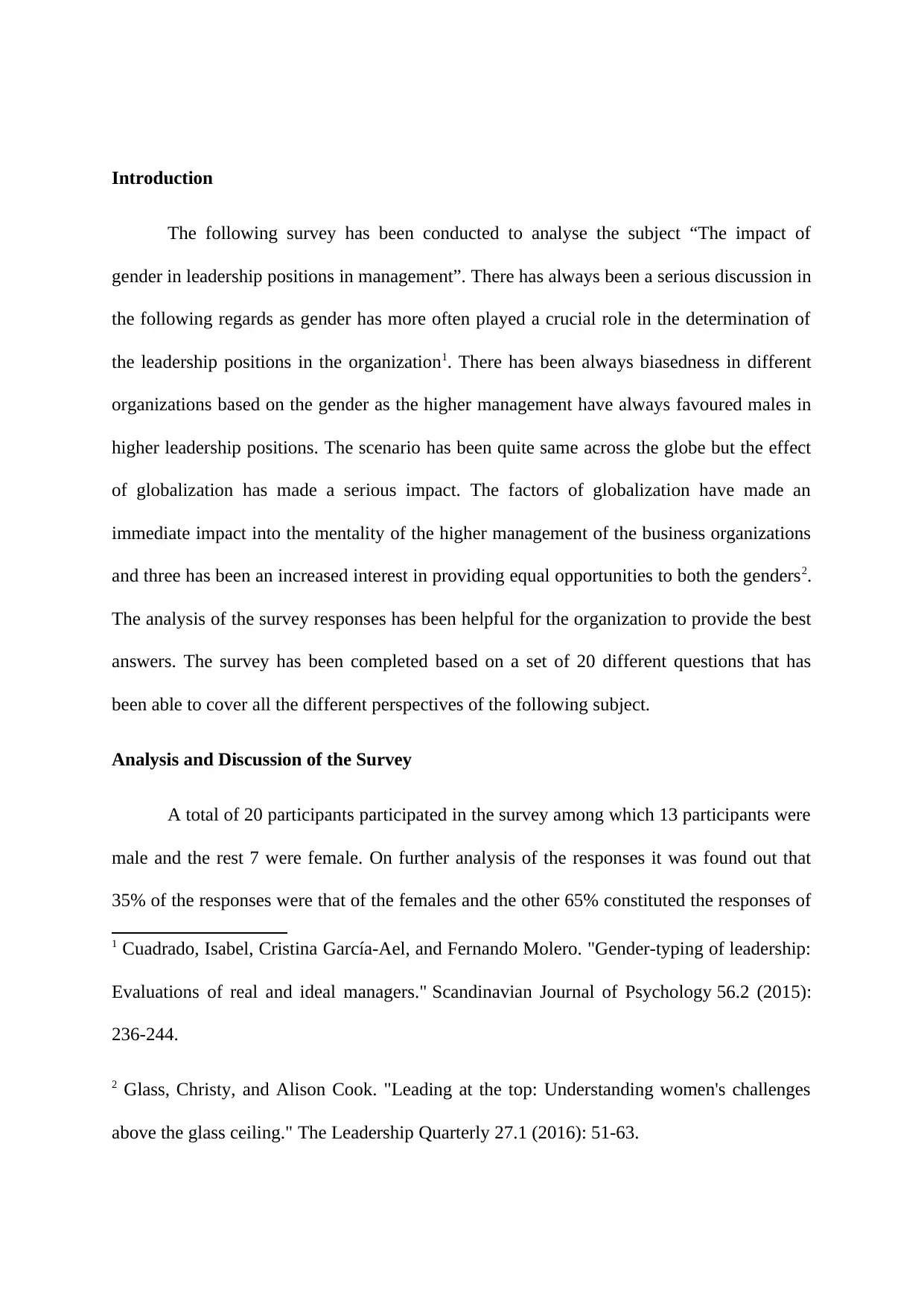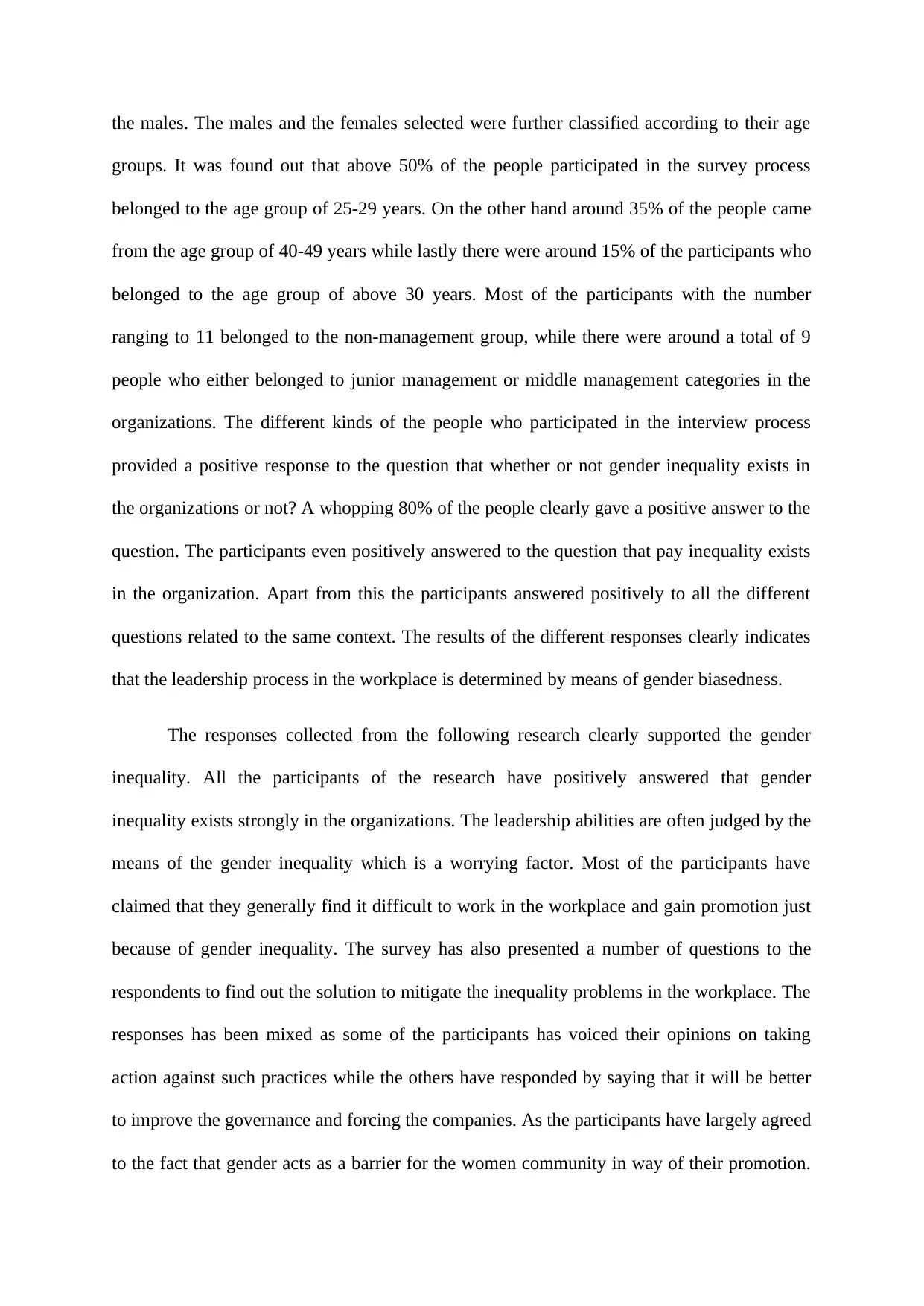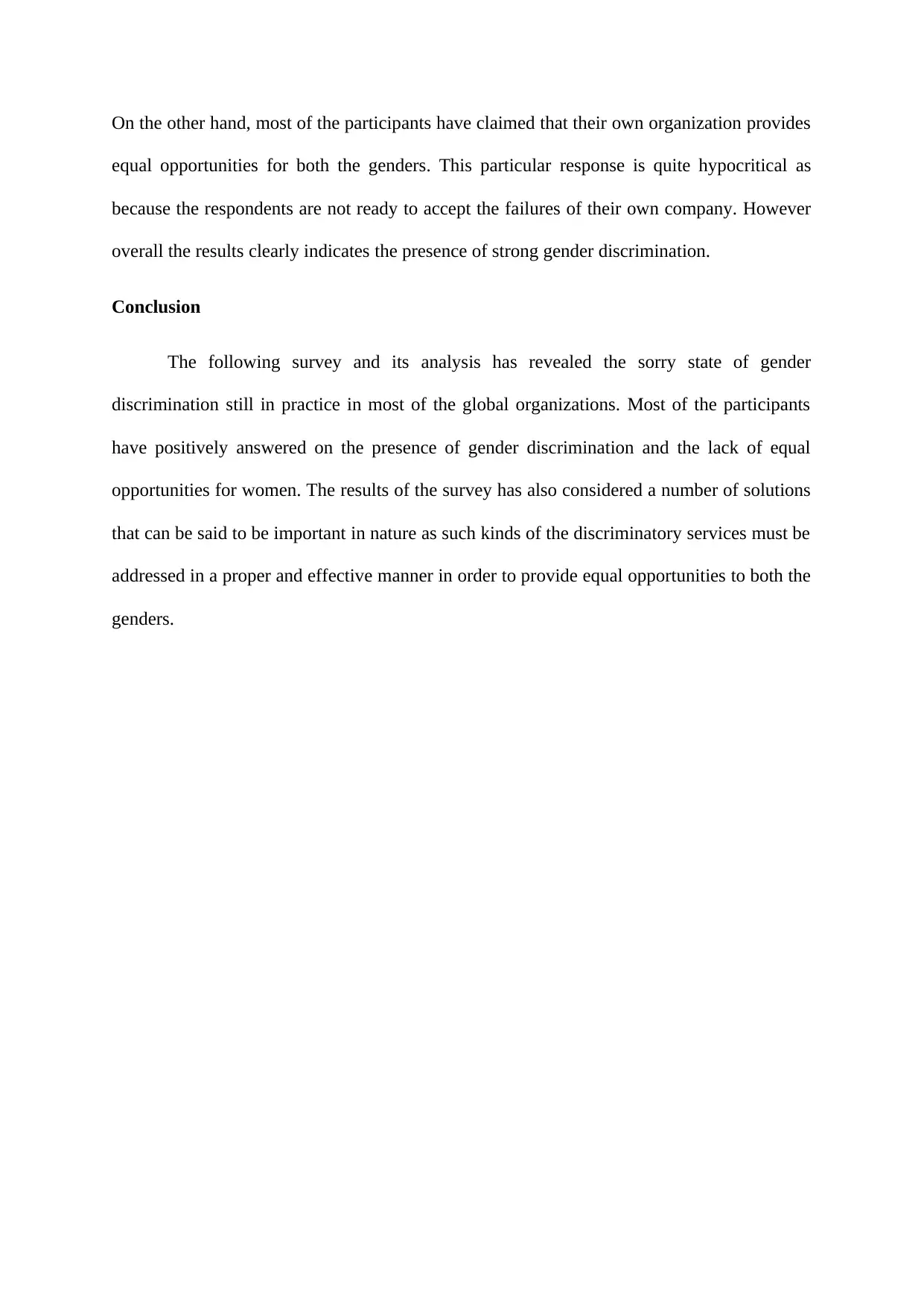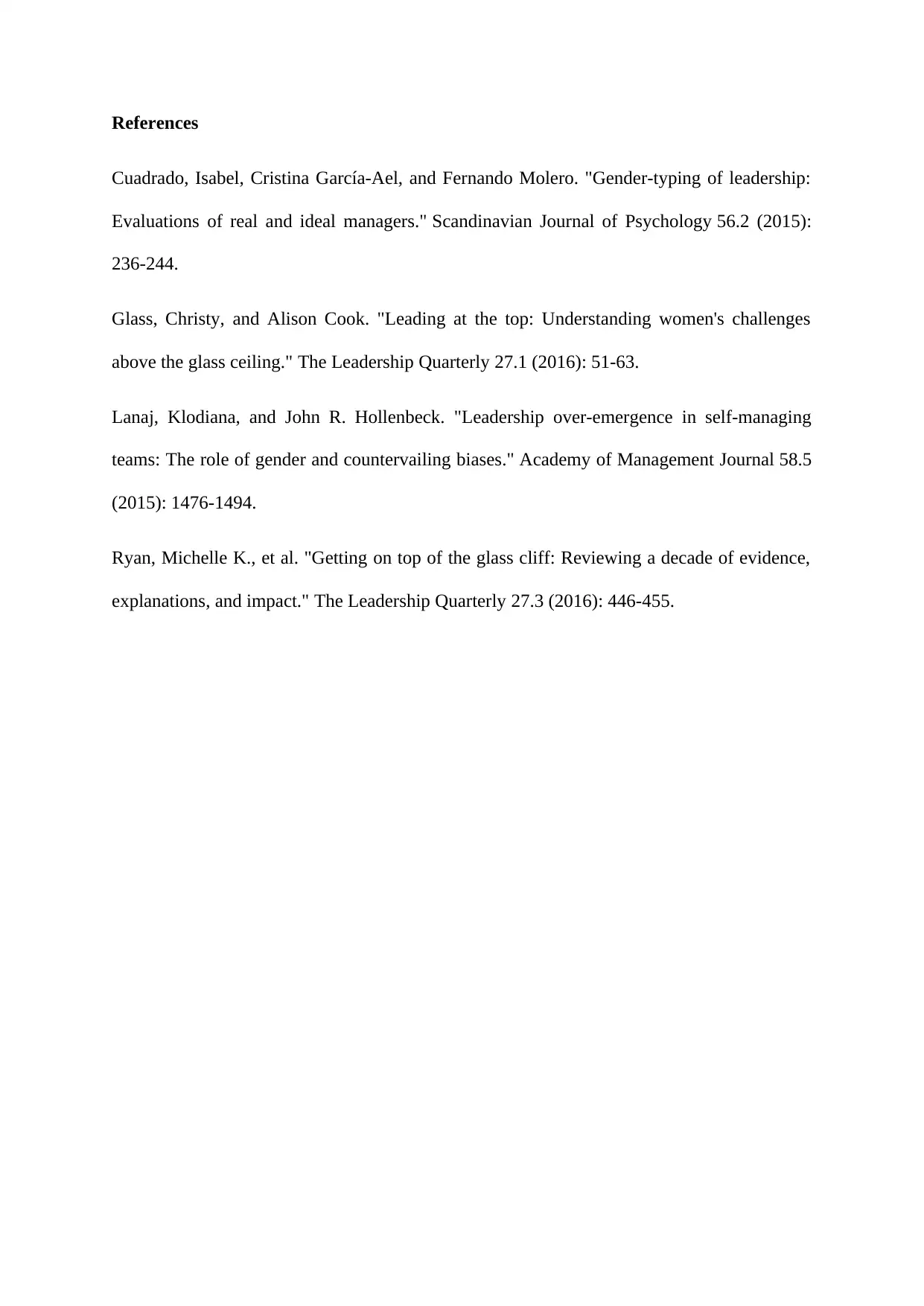Gender Impact in Leadership Positions: Survey Analysis Report
VerifiedAdded on 2022/10/17
|4
|931
|108
Report
AI Summary
This report presents an analysis of a survey conducted to examine the impact of gender in leadership positions within management. The survey, involving 20 participants (13 male, 7 female), investigated perceptions of gender inequality, pay disparities, and opportunities for advancement. Findings reveal that a significant majority of respondents believe gender bias exists in organizations, with many perceiving leadership abilities as being judged based on gender. The survey also explored potential solutions to mitigate these inequalities, revealing mixed responses. While some participants advocated for action against discriminatory practices, others suggested improving governance. Despite some respondents claiming their organizations offer equal opportunities, the overall results strongly indicate the presence of gender discrimination. The report concludes by emphasizing the need for addressing these issues to ensure equal opportunities for both genders.

Introduction
The following survey has been conducted to analyse the subject “The impact of
gender in leadership positions in management”. There has always been a serious discussion in
the following regards as gender has more often played a crucial role in the determination of
the leadership positions in the organization1. There has been always biasedness in different
organizations based on the gender as the higher management have always favoured males in
higher leadership positions. The scenario has been quite same across the globe but the effect
of globalization has made a serious impact. The factors of globalization have made an
immediate impact into the mentality of the higher management of the business organizations
and three has been an increased interest in providing equal opportunities to both the genders2.
The analysis of the survey responses has been helpful for the organization to provide the best
answers. The survey has been completed based on a set of 20 different questions that has
been able to cover all the different perspectives of the following subject.
Analysis and Discussion of the Survey
A total of 20 participants participated in the survey among which 13 participants were
male and the rest 7 were female. On further analysis of the responses it was found out that
35% of the responses were that of the females and the other 65% constituted the responses of
1 Cuadrado, Isabel, Cristina García‐Ael, and Fernando Molero. "Gender‐typing of leadership:
Evaluations of real and ideal managers." Scandinavian Journal of Psychology 56.2 (2015):
236-244.
2 Glass, Christy, and Alison Cook. "Leading at the top: Understanding women's challenges
above the glass ceiling." The Leadership Quarterly 27.1 (2016): 51-63.
The following survey has been conducted to analyse the subject “The impact of
gender in leadership positions in management”. There has always been a serious discussion in
the following regards as gender has more often played a crucial role in the determination of
the leadership positions in the organization1. There has been always biasedness in different
organizations based on the gender as the higher management have always favoured males in
higher leadership positions. The scenario has been quite same across the globe but the effect
of globalization has made a serious impact. The factors of globalization have made an
immediate impact into the mentality of the higher management of the business organizations
and three has been an increased interest in providing equal opportunities to both the genders2.
The analysis of the survey responses has been helpful for the organization to provide the best
answers. The survey has been completed based on a set of 20 different questions that has
been able to cover all the different perspectives of the following subject.
Analysis and Discussion of the Survey
A total of 20 participants participated in the survey among which 13 participants were
male and the rest 7 were female. On further analysis of the responses it was found out that
35% of the responses were that of the females and the other 65% constituted the responses of
1 Cuadrado, Isabel, Cristina García‐Ael, and Fernando Molero. "Gender‐typing of leadership:
Evaluations of real and ideal managers." Scandinavian Journal of Psychology 56.2 (2015):
236-244.
2 Glass, Christy, and Alison Cook. "Leading at the top: Understanding women's challenges
above the glass ceiling." The Leadership Quarterly 27.1 (2016): 51-63.
Paraphrase This Document
Need a fresh take? Get an instant paraphrase of this document with our AI Paraphraser

the males. The males and the females selected were further classified according to their age
groups. It was found out that above 50% of the people participated in the survey process
belonged to the age group of 25-29 years. On the other hand around 35% of the people came
from the age group of 40-49 years while lastly there were around 15% of the participants who
belonged to the age group of above 30 years. Most of the participants with the number
ranging to 11 belonged to the non-management group, while there were around a total of 9
people who either belonged to junior management or middle management categories in the
organizations. The different kinds of the people who participated in the interview process
provided a positive response to the question that whether or not gender inequality exists in
the organizations or not? A whopping 80% of the people clearly gave a positive answer to the
question. The participants even positively answered to the question that pay inequality exists
in the organization. Apart from this the participants answered positively to all the different
questions related to the same context. The results of the different responses clearly indicates
that the leadership process in the workplace is determined by means of gender biasedness.
The responses collected from the following research clearly supported the gender
inequality. All the participants of the research have positively answered that gender
inequality exists strongly in the organizations. The leadership abilities are often judged by the
means of the gender inequality which is a worrying factor. Most of the participants have
claimed that they generally find it difficult to work in the workplace and gain promotion just
because of gender inequality. The survey has also presented a number of questions to the
respondents to find out the solution to mitigate the inequality problems in the workplace. The
responses has been mixed as some of the participants has voiced their opinions on taking
action against such practices while the others have responded by saying that it will be better
to improve the governance and forcing the companies. As the participants have largely agreed
to the fact that gender acts as a barrier for the women community in way of their promotion.
groups. It was found out that above 50% of the people participated in the survey process
belonged to the age group of 25-29 years. On the other hand around 35% of the people came
from the age group of 40-49 years while lastly there were around 15% of the participants who
belonged to the age group of above 30 years. Most of the participants with the number
ranging to 11 belonged to the non-management group, while there were around a total of 9
people who either belonged to junior management or middle management categories in the
organizations. The different kinds of the people who participated in the interview process
provided a positive response to the question that whether or not gender inequality exists in
the organizations or not? A whopping 80% of the people clearly gave a positive answer to the
question. The participants even positively answered to the question that pay inequality exists
in the organization. Apart from this the participants answered positively to all the different
questions related to the same context. The results of the different responses clearly indicates
that the leadership process in the workplace is determined by means of gender biasedness.
The responses collected from the following research clearly supported the gender
inequality. All the participants of the research have positively answered that gender
inequality exists strongly in the organizations. The leadership abilities are often judged by the
means of the gender inequality which is a worrying factor. Most of the participants have
claimed that they generally find it difficult to work in the workplace and gain promotion just
because of gender inequality. The survey has also presented a number of questions to the
respondents to find out the solution to mitigate the inequality problems in the workplace. The
responses has been mixed as some of the participants has voiced their opinions on taking
action against such practices while the others have responded by saying that it will be better
to improve the governance and forcing the companies. As the participants have largely agreed
to the fact that gender acts as a barrier for the women community in way of their promotion.

On the other hand, most of the participants have claimed that their own organization provides
equal opportunities for both the genders. This particular response is quite hypocritical as
because the respondents are not ready to accept the failures of their own company. However
overall the results clearly indicates the presence of strong gender discrimination.
Conclusion
The following survey and its analysis has revealed the sorry state of gender
discrimination still in practice in most of the global organizations. Most of the participants
have positively answered on the presence of gender discrimination and the lack of equal
opportunities for women. The results of the survey has also considered a number of solutions
that can be said to be important in nature as such kinds of the discriminatory services must be
addressed in a proper and effective manner in order to provide equal opportunities to both the
genders.
equal opportunities for both the genders. This particular response is quite hypocritical as
because the respondents are not ready to accept the failures of their own company. However
overall the results clearly indicates the presence of strong gender discrimination.
Conclusion
The following survey and its analysis has revealed the sorry state of gender
discrimination still in practice in most of the global organizations. Most of the participants
have positively answered on the presence of gender discrimination and the lack of equal
opportunities for women. The results of the survey has also considered a number of solutions
that can be said to be important in nature as such kinds of the discriminatory services must be
addressed in a proper and effective manner in order to provide equal opportunities to both the
genders.
⊘ This is a preview!⊘
Do you want full access?
Subscribe today to unlock all pages.

Trusted by 1+ million students worldwide

References
Cuadrado, Isabel, Cristina García‐Ael, and Fernando Molero. "Gender‐typing of leadership:
Evaluations of real and ideal managers." Scandinavian Journal of Psychology 56.2 (2015):
236-244.
Glass, Christy, and Alison Cook. "Leading at the top: Understanding women's challenges
above the glass ceiling." The Leadership Quarterly 27.1 (2016): 51-63.
Lanaj, Klodiana, and John R. Hollenbeck. "Leadership over-emergence in self-managing
teams: The role of gender and countervailing biases." Academy of Management Journal 58.5
(2015): 1476-1494.
Ryan, Michelle K., et al. "Getting on top of the glass cliff: Reviewing a decade of evidence,
explanations, and impact." The Leadership Quarterly 27.3 (2016): 446-455.
Cuadrado, Isabel, Cristina García‐Ael, and Fernando Molero. "Gender‐typing of leadership:
Evaluations of real and ideal managers." Scandinavian Journal of Psychology 56.2 (2015):
236-244.
Glass, Christy, and Alison Cook. "Leading at the top: Understanding women's challenges
above the glass ceiling." The Leadership Quarterly 27.1 (2016): 51-63.
Lanaj, Klodiana, and John R. Hollenbeck. "Leadership over-emergence in self-managing
teams: The role of gender and countervailing biases." Academy of Management Journal 58.5
(2015): 1476-1494.
Ryan, Michelle K., et al. "Getting on top of the glass cliff: Reviewing a decade of evidence,
explanations, and impact." The Leadership Quarterly 27.3 (2016): 446-455.
1 out of 4
Related Documents
Your All-in-One AI-Powered Toolkit for Academic Success.
+13062052269
info@desklib.com
Available 24*7 on WhatsApp / Email
![[object Object]](/_next/static/media/star-bottom.7253800d.svg)
Unlock your academic potential
Copyright © 2020–2025 A2Z Services. All Rights Reserved. Developed and managed by ZUCOL.





